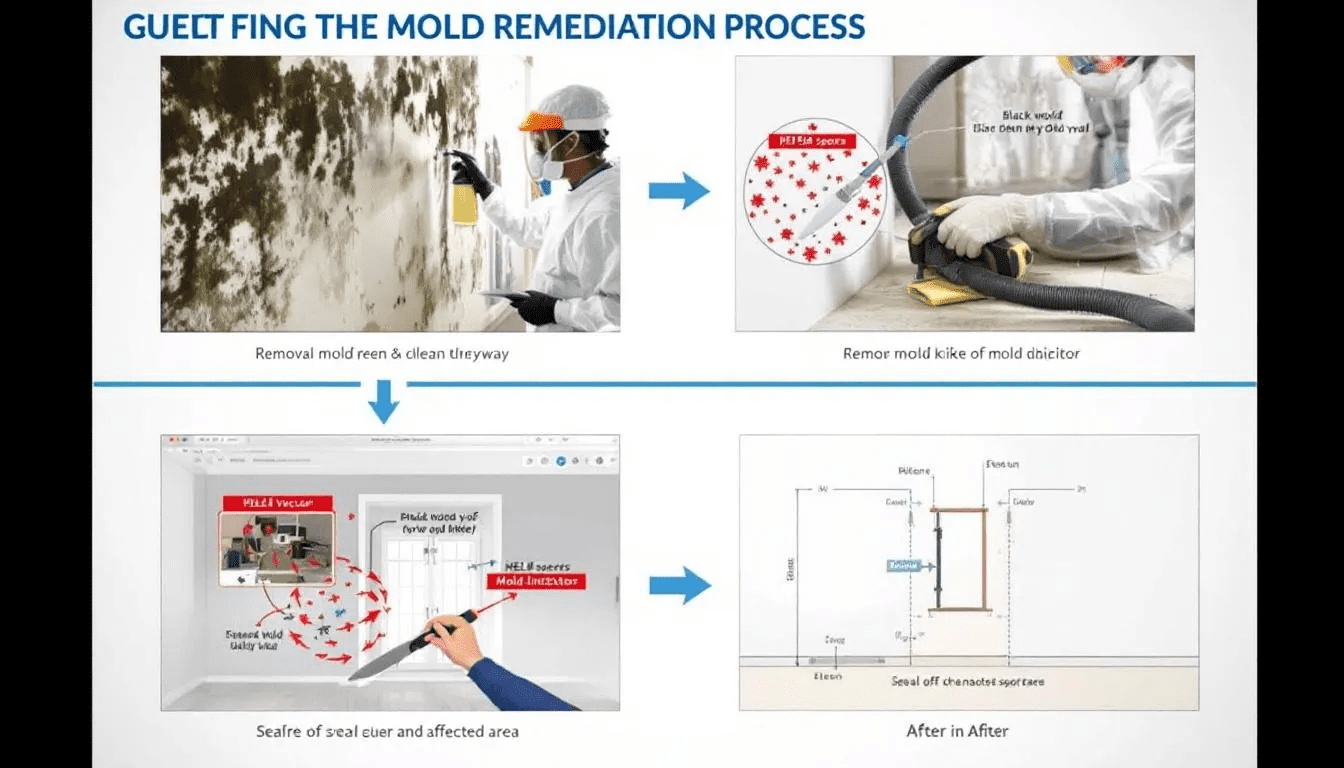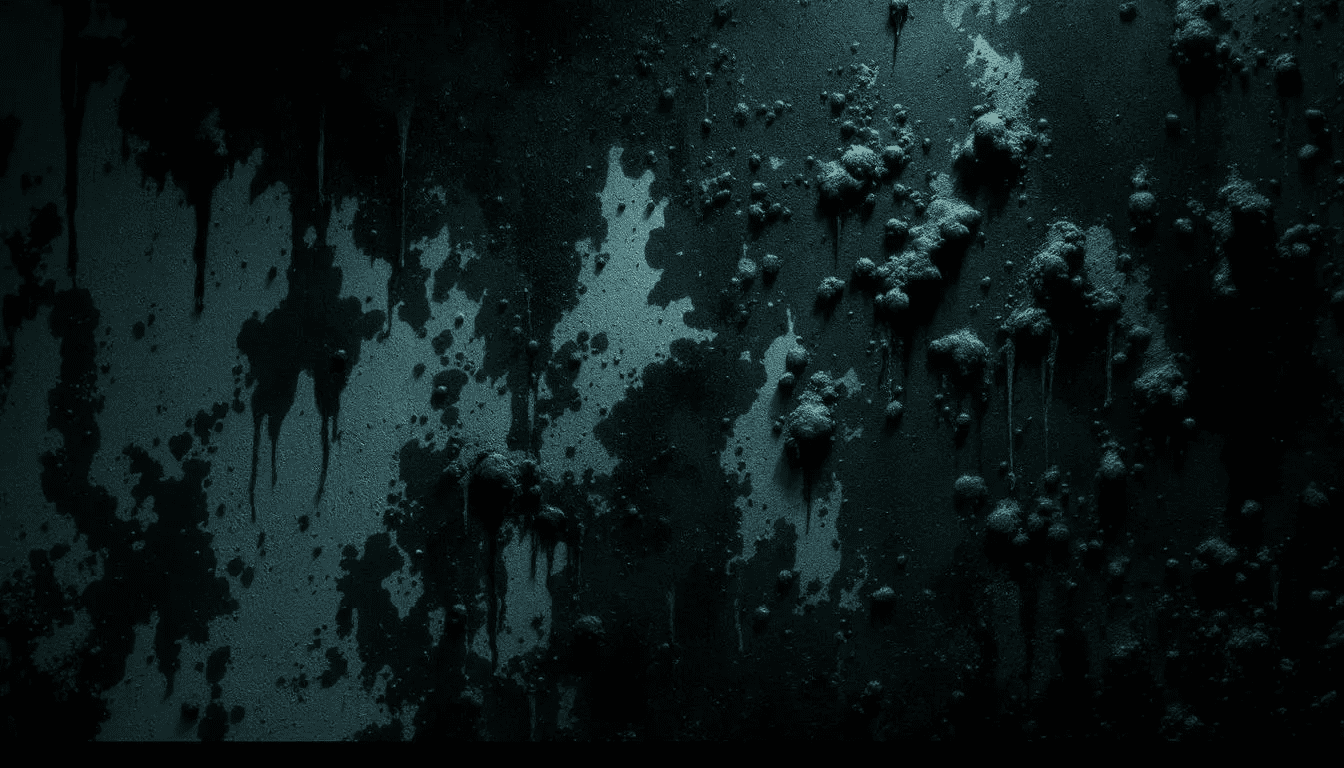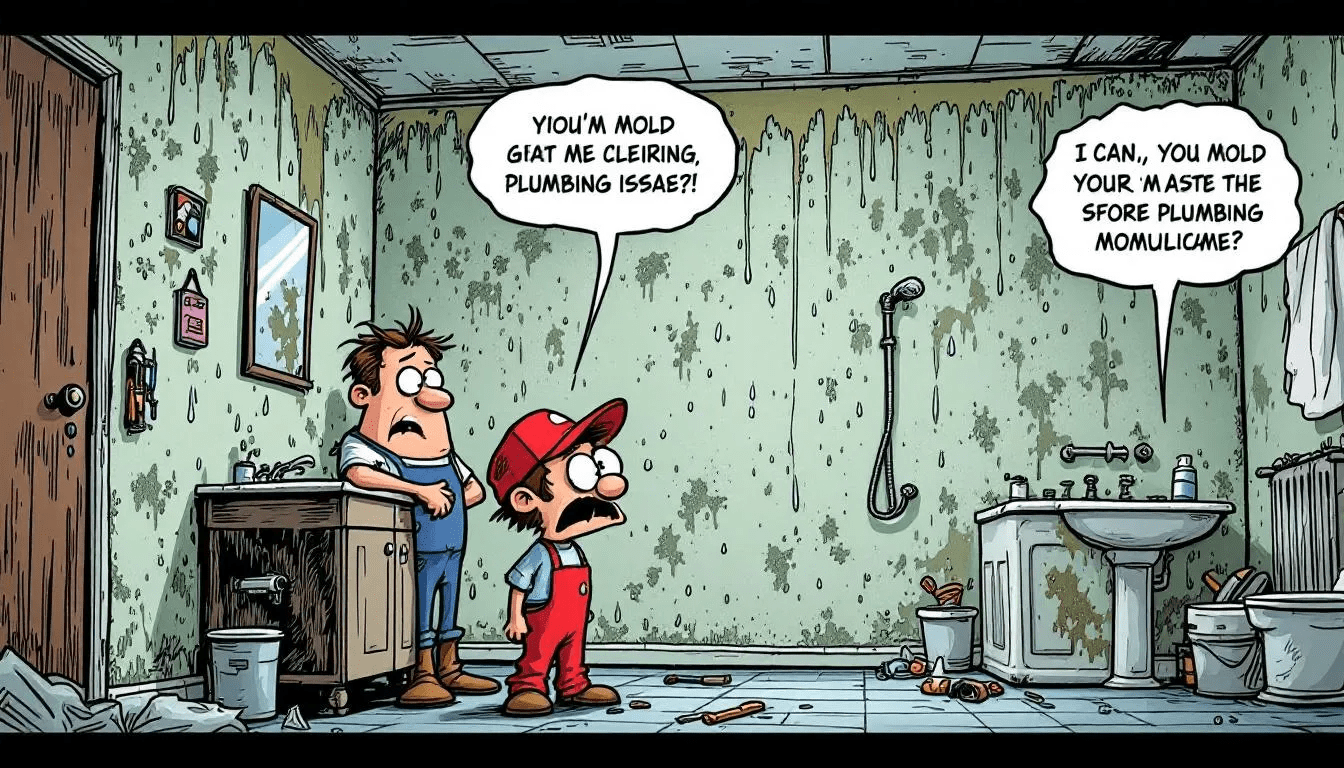What is mold remediation process? It’s assessing, removing, and preventing mold in a property. This article will walk you through each step involved.
Key Takeaways
Mold remediation involves a series of steps including assessment, removal, cleaning, and testing, focusing on controlling mold levels rather than complete eradication.
Effective mold remediation is essential for protecting health, especially in vulnerable individuals, and involves thorough inspection, containment, and the use of Personal Protective Equipment (PPE).
Post-remediation testing and restoration are crucial steps to ensure safe re-occupancy and prevent future mold growth, with successful remediation determined by comprehensive clearance assessments.
Understanding Mold Remediation
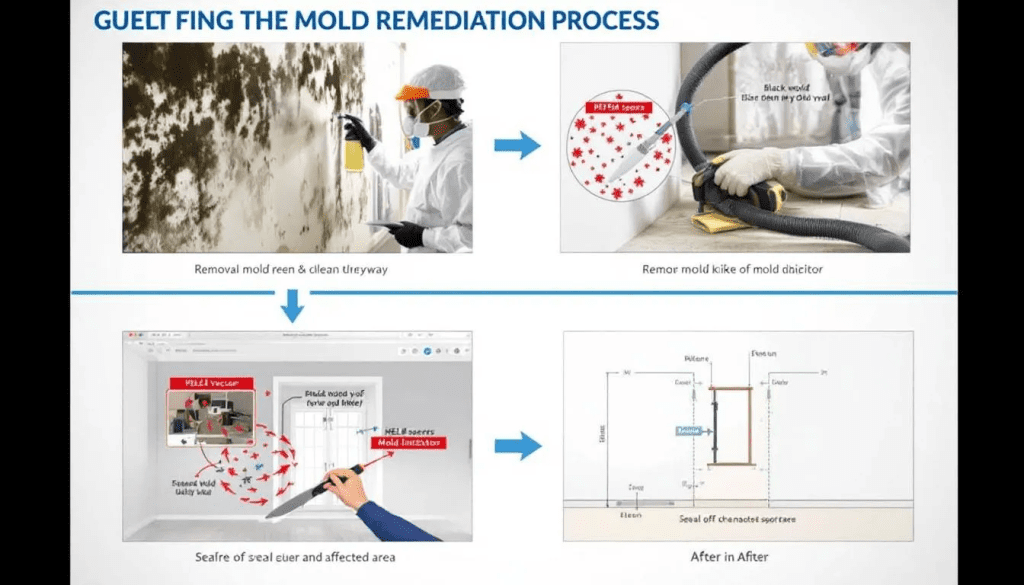
Mold remediation is a comprehensive process designed to eliminate harmful mold growth from your home or property. This process includes mold remediation services:
Testing
Removal
Demolition
Containment
Cleaning
Mold abatement
The primary focus is to address mold infestation and return mold levels to safe points.
While mold removal and mold remediation are often used interchangeably, there is a significant difference between the two. Complete mold removal is impossible and mostly undesirable, as mold can never be completely eradicated. Molds are natural organisms found both indoors and outdoors, but they require professional management to prevent health risks and property damage.
The mold remediation process is essential to control health hazards and protect property from damage. It typically starts with an emergency contact call to a professional mold remediation company, which then initiates the cleanup and restoration process. Understanding the intricacies of this process can help you make informed decisions when dealing with mold problems.
Importance of Mold Remediation
Mold can lead to significant health problems over time, making prompt action such as mold remediation in Sandy Springs crucial. Exposure to mold spores can cause serious health issues, infections, and allergies, particularly in individuals with compromised immune systems. Individuals with mold allergies are particularly affected, experiencing symptoms such as:
headaches
sore throat
congestion Prolonged exposure can also lead to adverse health effects, including:
respiratory problems
other infections.
Effective drying is essential to prevent mold from developing, as mold can start growing within 24 to 48 hours in damp conditions. Thorough drying of areas affected by mold is critical to stopping future mold growth and addressing moisture mold.
Post-remediation testing verifies the effectiveness of the mold removal process by ensuring the remediated area is safe for re-occupancy.
When to Consider Mold Remediation
Certain signs indicate the need for professional mold remediation. Common symptoms of mold exposure include persistent headaches, sore throat, and nasal congestion. If you notice these symptoms, it is essential to consider the possibility of mold in your home.
Visible mold growth or a persistent musty smell are key indicators that remediation is needed. The presence of active mold—ongoing or spreading mold growth—should be addressed promptly during remediation to prevent further infestation and recurrence. Specifically:
Mold tends to grow in damp spots.
Discoloration or a musty odor are strong signals that mold is present.
Mold removal becomes necessary when mold levels are abnormally high.
If you suspect mold in your home, it is crucial to identify and remove it with professional help. Mold remediation specialists can assess the extent of mold problems and ensure that the mold cleanup process is thorough and effective, preventing future mold growth.
Understanding Mold Growth
Mold growth is a persistent problem in both residential and commercial buildings, especially in areas where moisture levels are high. Mold spores are microscopic particles that are always present in the air, but they only develop into visible mold when they land on damp surfaces and find the right conditions to thrive. Common sources of moisture that contribute to mold growth include leaks, condensation, flooding, and poor ventilation. When these conditions are present, mold can quickly spread, leading to health concerns and property damage.
Understanding what causes mold growth is essential for effective mold remediation. Mold remediation companies focus on identifying and addressing the underlying moisture issues that allow mold to flourish. By controlling humidity, fixing leaks, and improving airflow, mold remediation specialists can help prevent future mold growth. Regular monitoring of moisture levels and prompt attention to water damage are key steps in keeping your property mold-free.
Initial Assessment and Inspection
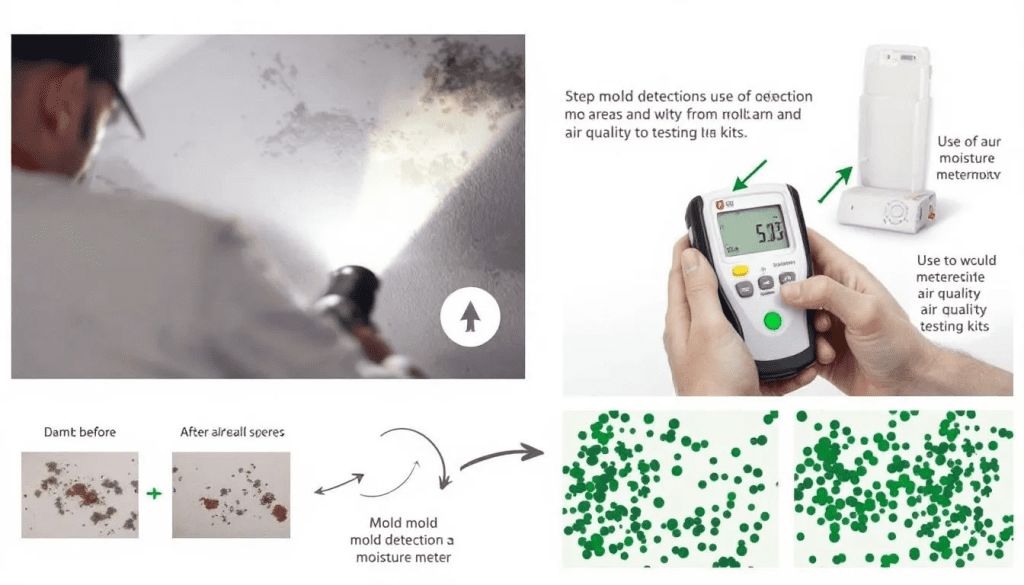
The mold remediation process begins with a comprehensive inspection. This includes a moisture survey and an air quality assessment. This initial assessment helps specialists determine the extent of mold damage and identify the cause of mold growth. During the assessment, professionals look for potential hiding spots and evaluate the level of contamination to develop an effective remediation plan.
Specialists use various methods to inspect for mold, including visual inspection and technology to detect hidden water sources. After the assessment, the expert provides a detailed report, outlining the steps for the remediation process and a removal quote. Identifying the moisture source that promotes mold growth is crucial for developing a successful remediation plan. The initial assessment can also provide the documentation needed for an insurance claim related to mold damage.
Visual Inspection
Visual inspection is a crucial step in identifying mold growth and assessing water damage in the property. Common areas where black mold can be found include: discover mold – Bathrooms – Basements – Sink cabinets – Window sills, and mold growing.
Specialists often use plastic or polyurethane sheeting to minimize the spread of mold spores during the inspection.
Moisture Mapping
Detecting hidden moisture is essential in mold remediation, as it helps identify areas at risk for mold growth. Professionals often utilize thermal imaging cameras during visual inspections to detect hidden moisture. Specialized moisture mapping tools help visualize areas with high moisture levels that may not be visible to the naked eye.
Using both thermal imaging cameras and moisture mapping tools allows for a comprehensive approach to locating moisture sources, enhancing the effectiveness of mold remediation efforts. Identifying and addressing these moisture sources is crucial to prevent future mold growth.
Assessing Mold Damage
A thorough assessment of mold damage is the foundation of any successful mold remediation process. When a mold remediation specialist arrives on site, they begin by inspecting the affected area to determine the extent of mold growth and the types of mold present. This assessment includes checking for visible mold, as well as using specialized equipment like moisture meters and thermal imaging cameras to detect hidden mold and moisture behind walls, under flooring, or in ceilings.
The findings from this inspection help the mold remediation contractor develop a tailored remediation plan. This plan outlines the steps needed for mold removal, cleaning, and disinfection of all affected areas, as well as the repair or replacement of damaged building materials. By accurately assessing the scope of the mold problem and the condition of building materials, the remediation process can be carried out efficiently and effectively, ensuring that all mold damage is addressed and future mold growth is prevented.
Containment Strategies
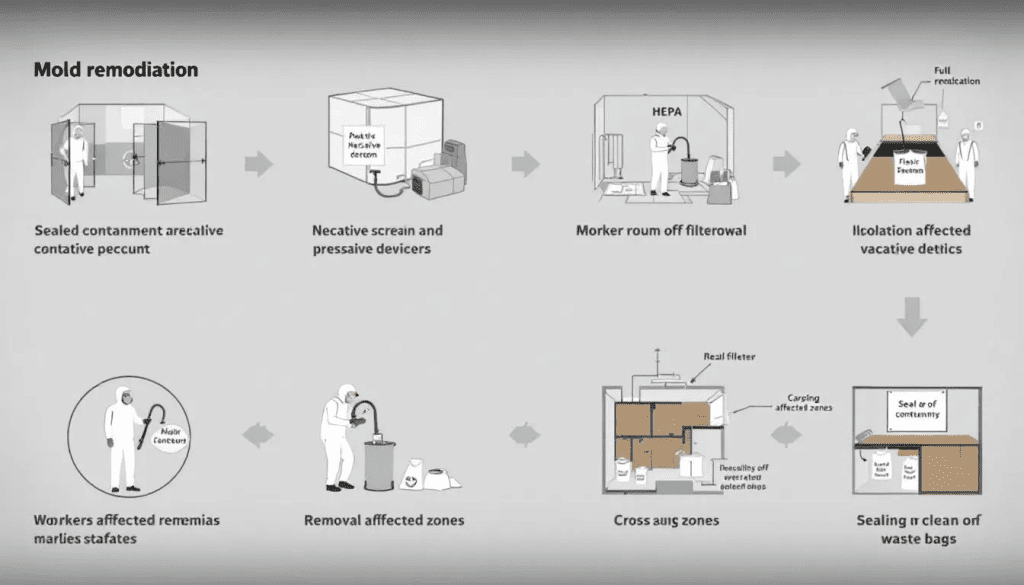
Containment procedures are essential in preventing mold spores from spreading during remediation. Experts isolate contaminated areas using physical barriers such as plastic sheeting, which helps minimize the risk of spores escaping into unaffected zones. It is also important to inspect and protect unaffected areas to ensure their safety and integrity throughout the remediation process. These containment strategies are crucial to maintaining low airborne spore levels and ensuring the effectiveness of the remediation process.
Proper disposal of contaminated gear is critical to prevent the spread of mold spores after remediation. Safety protocols during mold remediation involve methods to maintain low airborne spore levels, including the use of containment and proper ventilation.
Establishing Containment Zones
Establishing containment zones is crucial to isolate contaminated areas and prevent cross-contamination. The purpose of containment during mold remediation is to eliminate the spread of mold spores to other areas. Attempting to remove mold without proper containment triggers mold spores and can contaminate clean areas.
Limited containment consists of a single layer of polyethylene sheeting to enclose moldy areas. Using barriers such as plastic sheeting helps ensure that mold spores do not escape the tightly sealed contaminated area.
Access to contained areas during mold remediation is typically through a slit entry covered by a flap in the affected areas.
Negative Air Pressure
Negative air pressure is employed during mold remediation to isolate the contaminated area and prevent mold spores from spreading. This technique involves using exhaust fans to exhaust air outside the building, maintaining negative pressure within the containment zone.
The containment area should billow inward if negative air pressure is functioning correctly. This ensures that any mold spores released during the remediation process are contained and do not spread to other areas, enhancing indoor air quality.
Importance of Air Filtration
Air filtration is a vital part of the mold remediation process, as it helps control the spread of mold spores during cleanup. When mold is disturbed, spores can become airborne and travel to other parts of the building, potentially causing new mold growth and health risks for occupants. To combat this, mold remediation companies use advanced air filtration systems, such as HEPA filters and air scrubbers, to capture and remove mold spores and other contaminants from the air.
These air filtration devices are strategically placed in the remediation area to continuously clean the air throughout the process. By removing airborne mold spores, air filtration not only protects the health of workers and occupants but also helps prevent future mold growth by reducing the number of spores that can settle and colonize new surfaces. Regular use of air filtration during and after remediation is an effective way to maintain a safe, mold-free environment.
Personal Protective Equipment (PPE)
Using personal protective equipment (PPE) is essential to safeguard remediation workers from harmful mold spores. PPE significantly reduces the risk of exposure to mold spores, thereby protecting the health of workers involved in remediation. Establishing protocols for PPE usage helps ensure that mold remediation efforts significantly reduce the risk of airborne mold exposure.
Protocols involve wearing appropriate PPE, maintaining proper ventilation, and minimizing direct contact with mold. Following these protocols is crucial for the safety of both the remediation workers and the occupants of the building.
Types of PPE Used
Essential PPE for mold remediation includes:
Disposable coveralls
Long gloves, designed to resist mold and protect hands
Non-vented goggles, to protect the eyes from irritants
N95 respirators, to prevent inhalation of spores
Full-face respirators, also to prevent inhalation of spores
The use of Personal Protective Equipment (PPE) is crucial during mold remediation to protect workers from exposure to harmful spores. Using the proper equipment is essential for safeguarding health during the mold remediation process.
Safety Protocols
A qualified mold remediation contractor should adhere to safety protocols and follow EPA guidelines during the remediation process. Safety protocols are essential to minimize exposure to mold spores during remediation. EPA guidelines provide standards for safe mold remediation practices.
Adhering to these guidelines ensures that the remediation process is both effective and safe for everyone involved.
Mold Remediation Equipment and Supplies
Effective mold remediation relies on the use of specialized equipment and supplies designed to safely remove mold and prevent its return. Mold remediation companies equip their teams with personal protective equipment (PPE) such as respirators, gloves, and eye protection to safeguard against exposure to mold spores. In addition, they use powerful cleaning solutions, disinfectants, and antimicrobial agents to kill mold and inhibit future growth on affected surfaces.
To control moisture levels and prevent mold spores from spreading, remediation contractors deploy equipment like dehumidifiers, fans, and negative air machines. These tools help dry out the affected areas and maintain proper humidity, which is essential for preventing mold from returning. The use of proper equipment and cleaning techniques ensures that the remediation process is thorough, effective, and safe for everyone involved.
Removal of Mold-Infested Materials
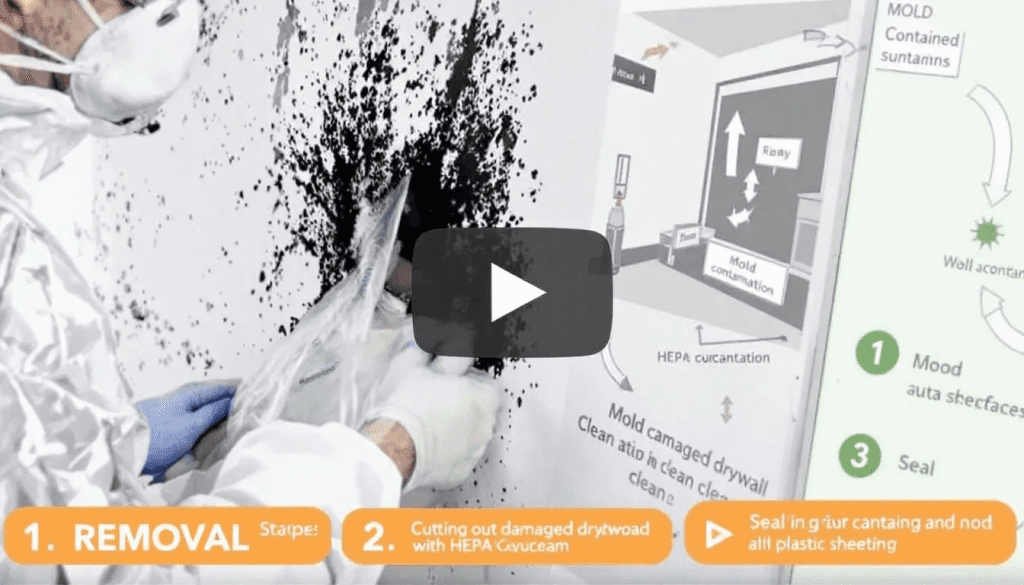
The removal of mold-infested materials is a critical step in the mold remediation process. The materials that are typically removed during mold remediation include drywall, carpeting, and insulation. The amount of mold growth plays a significant role in the remediation process. Additionally, the types of surfaces involved also influence how remediation is carried out.
Disposal of materials is typically necessary during the remediation process when mold is found on porous materials. The removal of mold-infested materials must adhere to strict EPA standards to ensure safety and effectiveness.
During the mold remediation process, a contents pack out occurs where salvable items are removed and taken off-site for restoration.
In severe cases, extensive contamination or damage may require additional restoration steps, such as plumbing and electrical repairs, to fully restore the property.
Removing Porous Materials
Types of porous materials that need to be removed during mold remediation include:
Carpeting
Clothing
Plaster
Drywall
Fabric-covered furniture
Common porous materials that require removal include items like drywall and carpeting, as well as plaster, fabric-covered furniture, and other affected materials.
The recommended disposal method for moldy items is to dispose of them in a regular landfill, following local regulations. Removing these materials ensures that mold spores do not remain and continue to cause problems.
Cleaning Non-Porous Surfaces
Cleaning non-porous surfaces is critical in mold remediation to ensure that all mold spores are effectively removed, preventing future growth. Techniques for cleaning non-porous surfaces include thorough scrubbing and the use of appropriate cleaning agents to eliminate any remaining mold spores.
Using HEPA vacuums is essential in the cleaning process, as they are designed to capture and contain airborne mold spores, preventing them from spreading. To disinfect surfaces after cleaning, EPA-approved biocides are applied to effectively kill remaining mold spores and prevent future growth.
Cleaning and Disinfecting
Negative air machines and HEPA vacuums play key roles in maintaining and improving air quality:
Negative air machines are essential for maintaining air quality by filtering out mold spores from the contaminated area.
HEPA vacuums are used for improving indoor air quality during the cleaning process.
Air filtration involves the use of negative air machines with HEPA air filters and air scrubbers to enhance the removal of airborne mold spores and ensure the efficiency of the HVAC system.
Non-porous surfaces are cleaned using specific detergents and brushes to remove mold effectively without spreading spores, ensuring a mold free environment. Effective cleaning involves scrubbing mold from hard surfaces using detergent and ensuring everything is dried thoroughly.
Various cleaning techniques and sanitization methods can be applied to belongings affected by mold, including furniture and clothing. Additionally, fogging equipment can be used for deodorization and odor removal after mold cleanup, ensuring a thorough and odorless remediation.
HEPA Vacuuming
HEPA vacuums are crucial in capturing mold spores from both surfaces and the air. Professionals use HEPA-approved vacuums to clean surfaces during mold remediation. This ensures that any escaped spores are contained and do not spread to other areas.
Application of Biocides
EPA-approved biocide are essential for disinfecting areas and eradicating any remaining mold spores. Biocides are applied during the mold remediation process as part of the antimicrobial application to kill mold spores, using EPA-approved biocide and commercial-grade antimicrobial sprays.
After biocide is applied, it must set overnight to be effective. This ensures that all mold spores are killed, and the area is safe for re-occupancy.
Drying the Area
Thorough drying prevents mold spores from settling and germinating in remediated spaces. Mold clearance testing includes measuring moisture levels and assessing air quality as part of the verification process. Advanced tools are used during clearance testing to monitor temperature and humidity, influencing mold growth potential.
Post-remediation guidance often includes:
Enhancing ventilation
Consistently monitoring humidity levels to deter future mold growth
Ensuring that the area is completely dry to prevent mold from returning.
Use of Dehumidifiers and Fans
Dehumidifiers are essential for controlling humidity levels and aiding in the drying process. Dehumidifiers and fans are essential for reducing humidity levels and ensuring thorough drying.
Commercial-grade dehumidifiers and air movers are essential tools for effectively reducing moisture levels during the drying phase. Low grain refrigerant dehumidifiers are commonly used to maintain optimal humidity levels during the drying process. These devices work together to facilitate the drying process, which is critical to prevent future mold growth.
Monitoring Moisture Levels
Continuous monitoring of moisture levels ensures that all hidden wet areas are dried and helps confirm that the remediation process has been successful. Regular use of moisture meters helps ensure that humidity levels remain low to avoid mold resurgence.
Consistent monitoring of humidity can help:
Maintain levels between 30% and 50%, crucial for preventing mold.
Ensure that drying efforts are successful.
Keep humidity in check through regular moisture level checks.
Post-Remediation Testing
Post-remediation testing is crucial for confirming that the mold remediation process was successful and that the environment is safe. Inspection techniques also include evaluating air quality to identify mold presence. Once clearance testing is complete, restoration can begin, which might include replacing or fixing drywall, flooring, and insulation.
After confirming that mold levels are acceptable, any necessary restoration work can commence. This ensures that the area is safe for re-occupancy and that mold problems are effectively resolved.
Clearance Testing
The purpose of clearance testing is to assess the success of remediation and document safety for occupancy. Clearance testing involves:
Re-inspection of the area
Humidity readings
Visual checks
Airborne spore sampling, along with obtaining a clearance testing certificate.
During the final inspection after mold remediation, moisture levels, humidity, visible signs of mold, and air samples are checked. Successful mold remediation is determined when there is no mold smell or visible mold remains. A HEPA-approved vacuum cleaner is likely used to ensure any escaped spores are eliminated.
Reporting Results
Building occupants should be informed about the scope of the problem and planned remedial steps during the remediation process. During the remediation process, property owners and occupants have the ability to request a copy of inspection reports. This allows them to stay informed about the situation.
Recommendations after final testing might include improving ventilation, fixing leaks, and maintaining proper humidity levels. This ensures that the mold problem is resolved and reduces the likelihood of future mold growth.
Restoration and Repairs
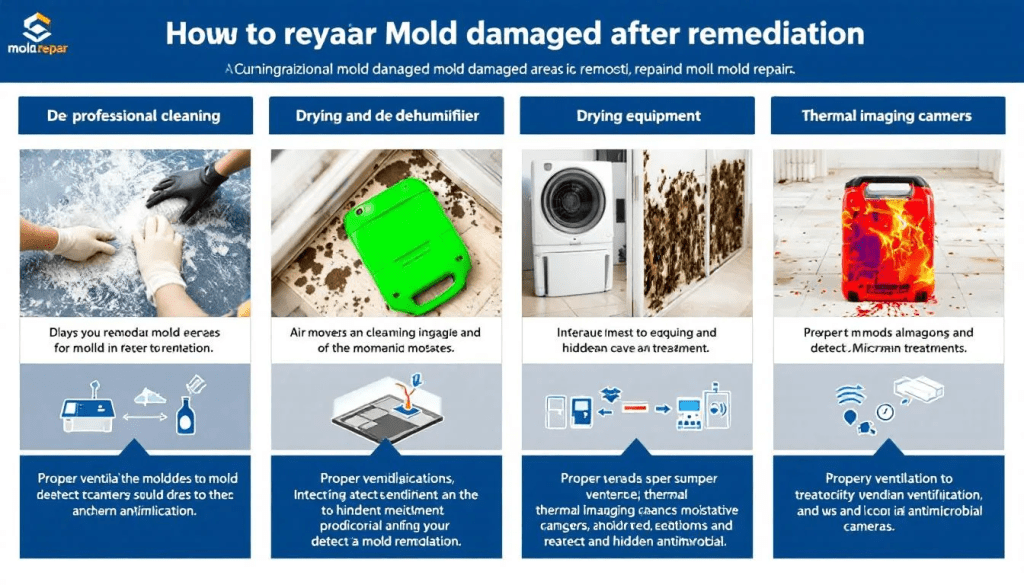
The restoration process aims to return properties to their original state, focusing on structural integrity and aesthetics. The restoration company phase may include both minor and major repairs, which can involve replacing drywall, property damage assessments, painting, or even reconstructing entire areas.
Documentation from clearance tests is crucial for property transactions and compliance with health regulations. Restoration companies often work directly with the insurance company to streamline the claims process and ensure proper documentation for property damage claims. The results of mold clearance testing dictate the next steps, which may include further remediation if mold levels remain high.
Repairing Damaged Areas
The restoration process involves repairing or replacing drywall, flooring, insulation, and possibly plumbing and electrical wiring. During mold restoration, materials such as drywall, subfloors, and other building materials might be removed.
Major repairs in the mold restoration process might include the reconstruction of various areas or rooms. This ensures that the property is restored to its original condition, free from mold damage.
Preventative Measures
Addressing moisture problem and leaks prior to remediation is essential to prevent mold growth and regrowth. Improving ventilation and fixing leaks are essential steps in reducing future mold growth risk.
Professionals recommend replacing insulation and addressing plumbing and electrical systems to prevent future mold issues. Repairs during restoration may include fixing damaged areas such as subfloors to ensure structural integrity.
Preventing Mold Growth in Specific Areas
Certain areas of a property, such as bathrooms, kitchens, and basements, are more prone to mold growth due to higher moisture levels and limited ventilation. Mold remediation specialists recommend several strategies to prevent mold in these high-risk zones. Installing and regularly using exhaust fans helps remove excess moisture from the air, while improving overall ventilation reduces the likelihood of mold taking hold.
Regular cleaning and inspection of these areas can help property owners catch mold problems early, before they become severe. Using mold-resistant materials and coatings on walls, ceilings, and floors can also provide an extra layer of protection against mold growth. By maintaining low moisture levels and promptly addressing leaks or water damage, property owners can keep their spaces mold free. Mold remediation companies can offer tailored advice and solutions to help prevent future mold growth and maintain a healthy indoor environment.
Choosing a Mold Remediation Specialist
Choosing the right mold remediation specialist is crucial for effective remediation. Verify that the mold remediation contractor holds certifications from respected organizations, indicating their expertise. Confirm that the remediation contractor is insured and licensed to protect against potential liabilities.
It’s essential to select a contractor with extensive experience in mold remediation, especially with properties similar to yours. This ensures that the specialist is well-equipped to handle the specific challenges of your mold problem.
Certification and Experience
Expertise and proper certification are crucial when selecting a mold remediation professional. Ensure that the specialist has the necessary qualifications and experience to effectively remediate mold in your home or property.
Evaluating Services and Costs
It’s important to compare services and prices among specialists to ensure fair and effective remediation. Compare multiple contractors to ensure you are getting comprehensive mold treatment rather than just surface cleaning.
Selecting the right mold remediation specialist involves evaluating their services, costs, and reputation. This ensures that you receive high-quality remediation services that address your mold problem effectively.
Summary
Mold remediation is a crucial process to ensure the health and safety of your home. From initial assessment to final restoration, each step is designed to effectively eliminate mold and prevent future growth. Understanding the importance of mold remediation and recognizing the signs when it is needed can help you take prompt action to address mold problems.
Choosing a qualified mold remediation specialist is essential for effective remediation. By following the detailed steps outlined in this guide, you can ensure that your home is mold-free and safe for your family. Addressing mold issues promptly and thoroughly can prevent health problems and property damage, ensuring a healthy living environment.
Frequently Asked Questions
What is the difference between mold removal and mold remediation?
Mold removal focuses on eliminating visible mold, whereas mold remediation is a thorough process aimed at controlling mold levels and preventing future growth. Therefore, remediation is the more comprehensive and effective approach.
How do I know if I need mold remediation?
You need mold remediation if you notice visible mold growth, experience persistent musty odors, or have health symptoms like headaches, sore throat, and congestion. Addressing these signs promptly can help maintain a healthy environment.
What are the health risks of mold exposure?
Mold exposure poses serious health risks, particularly respiratory issues, infections, and allergic reactions, with those sensitive to mold experiencing symptoms like headaches, sore throat, and congestion. It’s crucial to address mold presence to protect your health.
How long does the mold remediation process take?
The mold remediation process usually takes several days to weeks, depending on the size of the affected area and the level of infestation. Timely action and thorough procedures are essential for effective remediation.
How can I prevent future mold growth?
To prevent future mold growth, focus on resolving moisture issues, enhancing ventilation, and regularly monitoring humidity levels. Ensuring thorough drying and conducting post-remediation testing will help maintain a mold-free environment.

